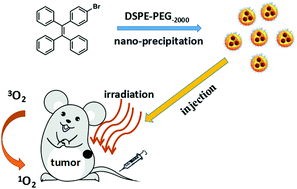(2-(4-Bromophenyl)ethene-1,1,2-triyl)tribenzene with aggregation induced emission for ablation of HeLa cells†
Abstract
It is of great importance for a photosensitizer to be soluble in aqueous solutions, while simultaneously remaining highly fluorescent. Towards this goal, (2-(4-bromophenyl)ethene-1,1,2-triyl)tribenzene (denoted as TPE-Br) with aggregation induced emission (AIE) was prepared. 1,2-Distearoyl-sn-glycero-3-phospho-ethanolamine-N-[methoxy(polyethyleneglycol)-2000] (DSPE-PEG-2000) coated TPE-Br nanoparticles (NPs) have a strong ability to generate singlet oxygen using singlet oxygen sensor green (SOSG) as a probe and still retain high fluorescence in aqueous solutions. In vitro cytotoxicity assays demonstrate that these NPs are able to kill HeLa cells effectively and the half-maximal inhibitory concentration (IC50) is as low as 12 μg mL−1. Furthermore, in vivo investigation suggests that TPE-Br NPs are able to inhibit the growth of the tumors after irradiation without adverse effects to normal organs, including the heart, liver, spleen, lung and kidney. This indicates the significantly low dark toxicity and excellent biocompatibility of such NPs.

- This article is part of the themed collection: Recent Progress on Aggregation-Induced Emission


 Please wait while we load your content...
Please wait while we load your content...